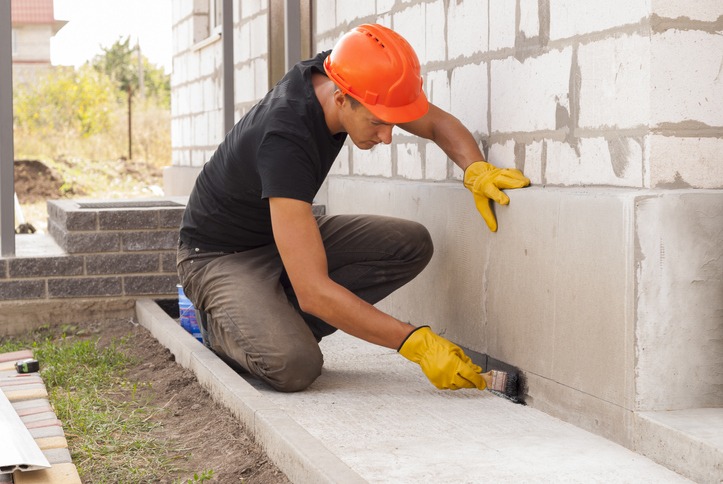Waterproofing your basement is an essential step in protecting your home from moisture damage, mold growth, and structural issues. With a wide variety of waterproofing methods available, it can be difficult to know which one is right for your home. In this article, we’ll take a look at some of the most common basement waterproofing methods and help you choose the right one for your needs.
Identify the causes of a wet basement
Before you can choose a waterproofing method, you need to identify the source of the moisture problem in your basement. Common causes of moisture in basements include high water tables, cracks in the foundation, and improper drainage. Once you’ve identified the cause of the problem, you can choose a waterproofing method that addresses the root cause.
Exterior Waterproofing
Exterior waterproofing involves excavating the soil around your home’s foundation and applying a waterproof membrane to the outside of the foundation walls. This method is effective in preventing moisture from entering the basement and can also help to prevent structural damage to your home’s foundation. However, it can be costly and disruptive to your landscaping.
If you are considering exterior waterproofing, it’s important to note that this method is best performed during new construction or major renovations. That’s because excavating the soil around your foundation is a time-consuming and labor-intensive process, and it can be difficult to do without disrupting your landscaping.
However, if you have identified that the cause of your moisture problem is due to the exterior of your home’s foundation, such as heavy rainfall, exterior waterproofing may be the most effective method for you.
Interior Waterproofing
Interior waterproofing involves installing a drainage system and sump pump inside the basement to collect and remove water that enters the space. This method is less disruptive and less expensive than exterior waterproofing, but it only addresses the symptoms of the problem and not the root cause.
One benefit of interior waterproofing is that it can be performed at any time, regardless of the age of your home. Additionally, because it does not involve excavating your landscaping, it is less disruptive and less costly than exterior waterproofing.
However, interior waterproofing is not as effective as exterior waterproofing at preventing moisture from entering your basement, and it does not address the root cause of the problem. Additionally, because it involves installing a drainage system and sump pump, it can take up valuable space in your basement.
Crack Injection
If the source of the moisture in your basement is due to cracks in the foundation walls, a crack injection may be the best option for you. This method involves injecting a waterproof material into the cracks to seal them and prevent water from entering the basement.
One benefit of crack injection is that it is a relatively quick and easy process, and it can be performed without disrupting your landscaping or excavating your foundation. Additionally, it is less expensive than exterior waterproofing and does not take up valuable space in your basement.
However, crack injection is only effective if the source of the moisture problem is due to cracks in your foundation walls. If the problem is due to a high water table or improper drainage, a crack injection may not be the best option for you.
Vapor Barriers
Vapor barriers are a type of waterproofing material that is installed on the interior walls of the basement. They work by preventing moisture from passing through the walls and into the basement space. This method is often used in conjunction with other waterproofing methods to provide additional protection against moisture.
One benefit of vapor barriers is that they are relatively inexpensive and easy to install. Additionally, they do not take up valuable space in your basement, and they can be effective at preventing moisture from entering your basement.
However, vapor barriers are only effective if the source of the moisture problem is due to moisture passing through the walls of your basement. If the problem is due to other factors, such as a high water table or improper drainage, vapor barriers may not be effective on their own.
Combination Methods
In many cases, a combination of waterproofing methods may be necessary to effectively address the moisture problem in your basement. For example, if the source of the problem is due to cracks in the foundation walls, a crack injection may be used in conjunction with exterior waterproofing to provide comprehensive protection against moisture.
When choosing a combination of waterproofing methods, it’s important to work with a professional who can evaluate your specific situation and recommend the best course of action.
Conclusion
Choosing the right waterproofing method for your basement is an important decision that can have long-lasting effects on the health and safety of your home. By identifying the source of the moisture problem and working with a professional, you can choose a waterproofing method that effectively addresses the root cause of the problem and provides comprehensive protection against moisture.
Remember to consider factors such as cost, disruption to your landscaping and interior space, and long-term effectiveness when making your decision. But the best decision would be to get a consultation and use the services of professionals like stellarwork.ca, who, thanks to their many years of experience, will choose the best method of waterproofing for your basement, carry out high-quality work and provide a guarantee for the work performed. With the right waterproofing method in place, you can enjoy peace of mind knowing that your home is protected against moisture damage and structural issues.
